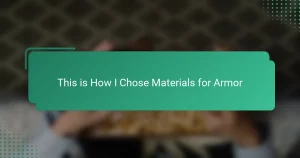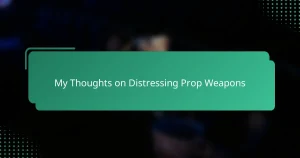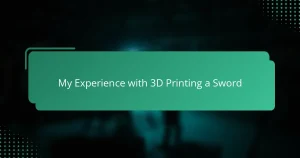Key takeaways
- Science fiction props, like the Desert Eagle, blend creativity and technology, inspiring both storytelling and real-world innovation.
- The design of the Desert Eagle prop emphasizes its bold presence through size, angular lines, and a polished finish, creating a futuristic aesthetic.
- Desert Eagle props enhance actor performances and engage fans during events, demonstrating their versatility and importance in film and culture.
- Improvements such as lighter materials, LED elements, and better ergonomics could enhance the prop’s usability while maintaining its iconic design.
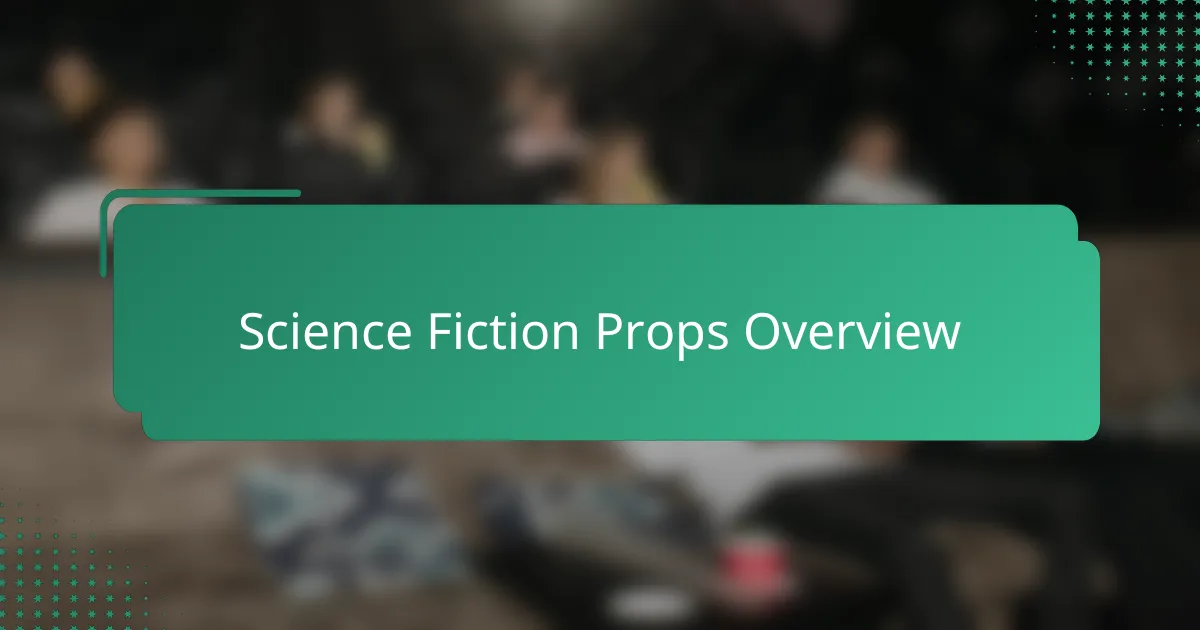
Science Fiction Props Overview
Science fiction props always grab my attention because they blend creativity with a hint of the impossible. They’re not just objects; they’re symbols of futuristic worlds and advanced technology that fuel our imaginations. Have you ever held a prop and wondered what story it could tell beyond the screen?
From sleek weapons to intricate gadgets, each prop is a mix of artistry and engineering. I remember the first time I saw a sci-fi blaster up close—it was like holding a piece of another universe in my hand. That sense of connection to an imagined world is what makes these props so captivating.
What fascinates me most is how these items evolve over time, reflecting both the era they were made in and the vision of the creators. It’s like they carry the pulse of their fictional worlds, while also inspiring real-world innovation. Don’t you think that’s a remarkable intersection between fiction and reality?
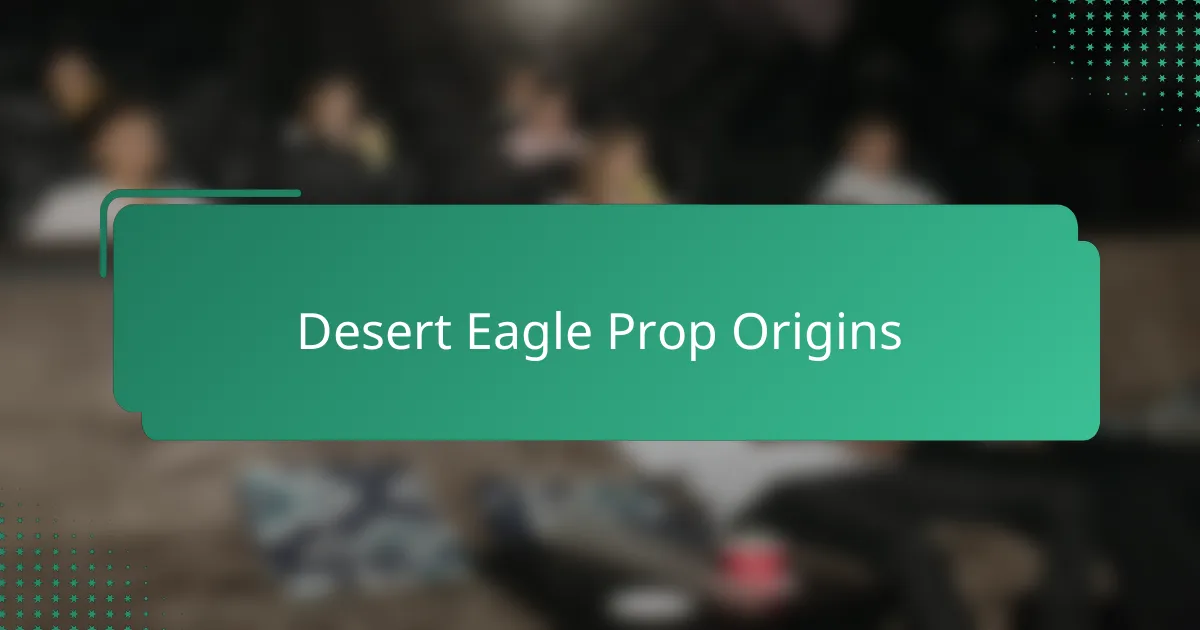
Desert Eagle Prop Origins
The Desert Eagle prop has roots that trace back to its real-world counterpart, but when adapted for the screen, it takes on a whole new identity. I’ve always been intrigued by how filmmakers amplified the gun’s bold design—making it seem even more imposing and futuristic than its actual model. It makes me wonder how much creative liberty goes into transforming something familiar into an icon of science fiction.
Looking back, the prop’s origins are tied to the late 20th century, when the Desert Eagle firearm itself was becoming famous for its size and power. Translating that into a prop meant enhancing those traits visually, so it could stand out in films and video games. I recall seeing the prop in early sci-fi movies and noticing how it caught my eye, not just because it was big, but because it looked like it belonged in a world far beyond our own.
What’s really fascinating is how this prop design has evolved while still paying homage to the original. It strikes me as a perfect example of how a functional object can inspire creative expression—and how a prop, born from a real gun’s design, becomes a symbol of futuristic storytelling. Isn’t it amazing how something so grounded can spark such imagination?
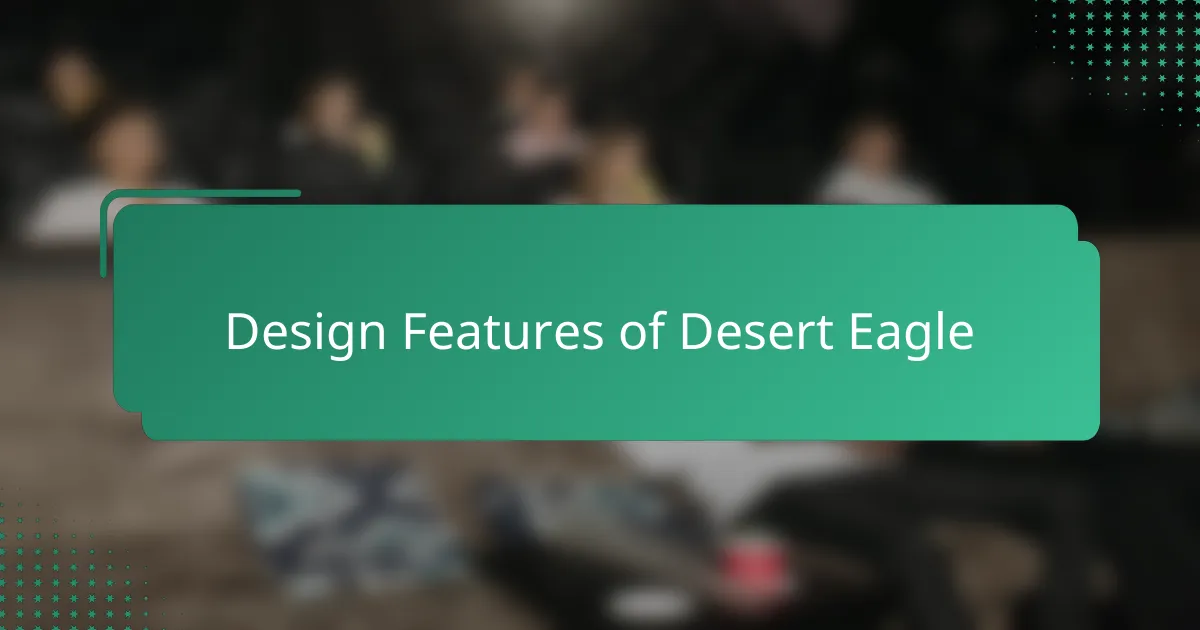
Design Features of Desert Eagle
One design feature that immediately stands out to me about the Desert Eagle prop is its sheer size and bulkiness. It’s almost as if the designers wanted to exaggerate the gun’s power through its massive frame, making it feel weighty and significant in any scene. I remember holding a replica once and being surprised at how heavy it felt, which really added to the sense that this was no ordinary firearm.
Another detail that caught my eye is the angular, almost geometric lines of the gun. It’s like the designers fused sharp edges with smooth planes to create a look that feels both modern and distinctly mechanical. This blend of forms gives the Desert Eagle prop a sculptural quality—almost like wearing a piece of futuristic armor rather than just carrying a weapon.
Have you noticed the way the metallic finish catches the light? The design often incorporates a high-polish or brushed metal look, emphasizing its high-tech appeal. To me, that reflective surface isn’t just about aesthetics—it’s a clever trick to make the prop feel like it belongs to a world where technology isn’t just advanced, but also polished and perfected. It makes you think, what kind of future crafts something so imposing yet so refined?
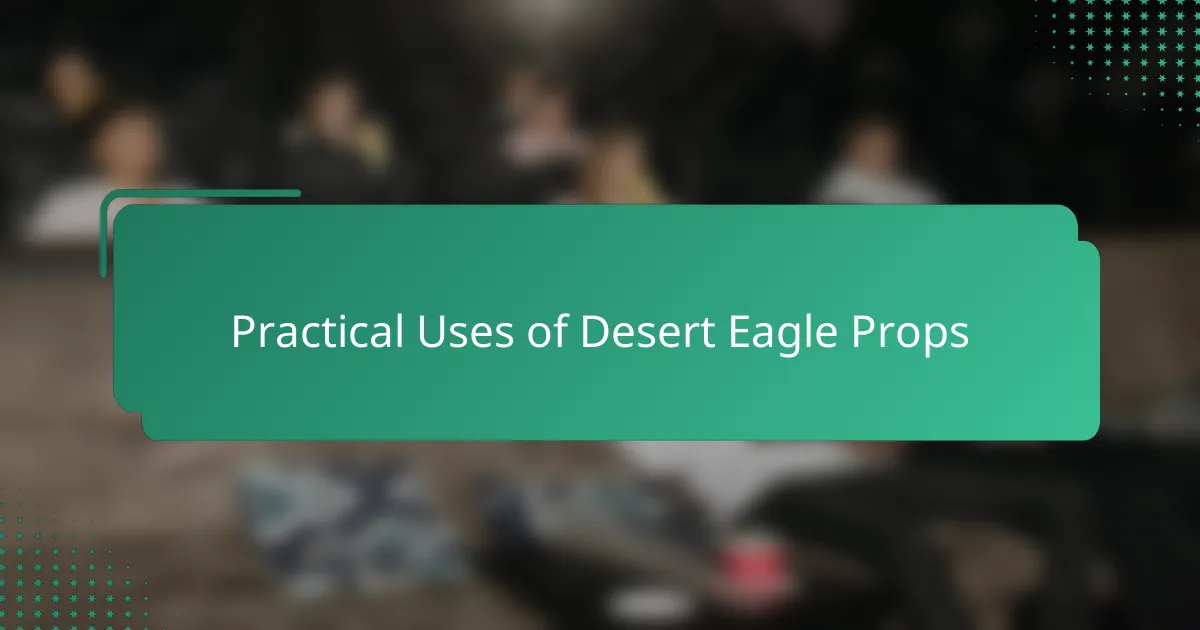
Practical Uses of Desert Eagle Props
When it comes to practical uses, Desert Eagle props are surprisingly versatile on set. I’ve seen them serve not only as focal points in action scenes but also as tools to help actors get into character—there’s something about gripping that hefty, detailed design that instantly boosts confidence. Have you ever noticed how a well-crafted prop can change the energy of a performance? This one definitely does.
In my experience, these props also shine during promotional events and fan conventions. Their iconic silhouette makes for eye-catching displays, sparking conversations and photo ops. I remember attending a convention where the Desert Eagle prop drew a crowd, and it was amazing to see fans light up just by holding or seeing the replica up close—it’s like the prop carries a bit of its sci-fi aura into the real world.
Technically speaking, the robust construction of Desert Eagle props means they can handle a fair amount of wear and tear, which is crucial for practical filmmaking. I’ve noticed that this durability allows for more dynamic stunts and interactions without the risk of damage, keeping that immersive illusion intact. Isn’t it fascinating how a prop’s physical practicality can enhance creative storytelling in such a subtle yet significant way?
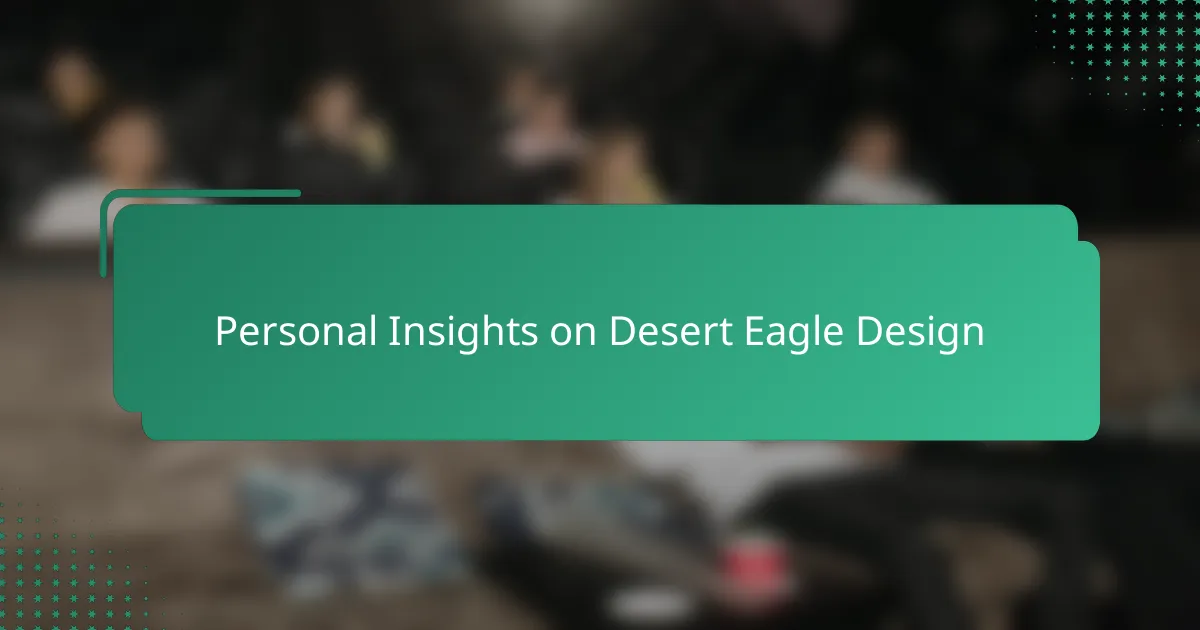
Personal Insights on Desert Eagle Design
What strikes me most about the Desert Eagle’s design is how boldly it declares its presence. It’s not just a weapon; it’s a statement piece with an almost aggressive personality. I’ve often thought that its oversized frame doesn’t just suggest power—it demands attention, almost like it owns the scene before a single shot is fired.
I remember the first time I held a replica—it felt surprisingly substantial, almost like carrying a piece of futuristic history. That weight gave the gun a grounded reality despite its sci-fi embellishments, making me appreciate how the designers balanced the fantastical with something tactile and believable. Don’t you find that blend of fantasy and realism is what makes props linger in your mind long after the movie ends?
Another detail I can’t ignore is the sharp, angular silhouette that feels both mechanical and sleek. It’s as if the designers envisioned a future where form and function are inseparable, crafting a shape that’s as much armor as it is a weapon. This balance of aesthetics and implied technology sparks my imagination—what kind of world produces such a tool, and what stories could it tell if it could speak?
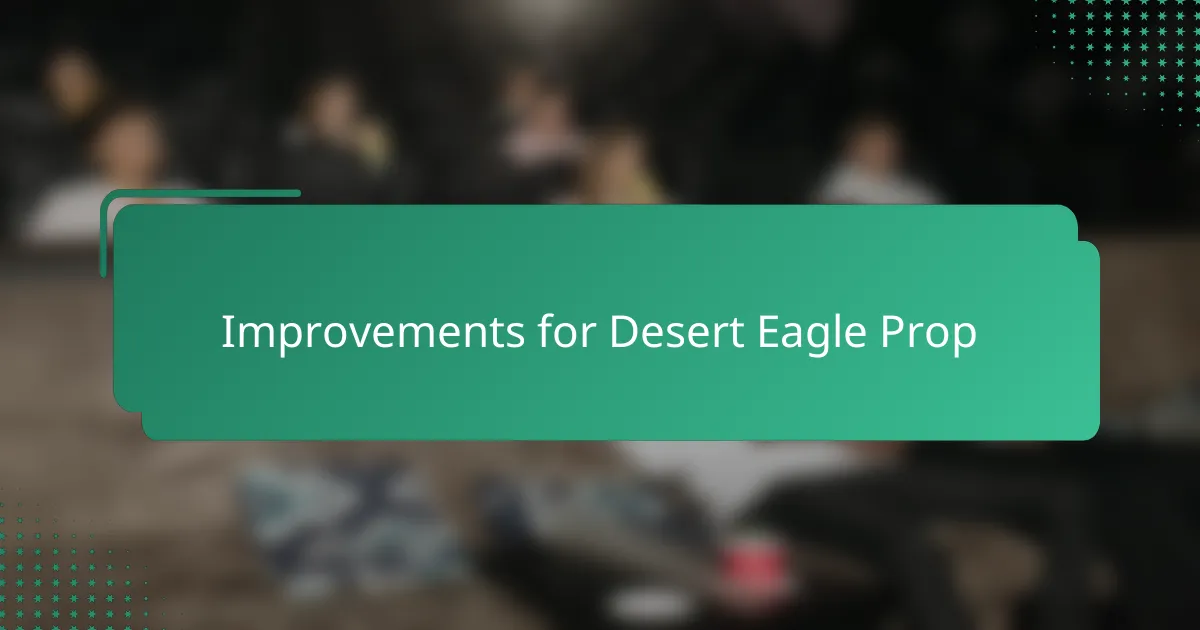
Improvements for Desert Eagle Prop
One improvement I would suggest for the Desert Eagle prop is to lighten its weight without sacrificing its imposing look. I recall trying to handle a replica that was so heavy it became tiring after a while, which might limit its use during long shooting sessions. Wouldn’t it be fantastic if the prop maintained that commanding presence but felt easier and more comfortable to wield?
Adding subtle LED lighting or glow elements could also elevate the futuristic vibe. Imagine holding the prop in a dimly lit set where soft pulses of light accentuate its angular lines—this could make it feel more alive and fitting for a sci-fi world. From my experience, these small touches can transform a prop from merely cool-looking to truly immersive.
Lastly, refining the ergonomics might enhance the actor’s interaction with the prop. I’ve noticed that sometimes bulky designs can feel awkward to grip or maneuver, which can pull you out of the scene. What if the designers balanced the Desert Eagle’s size with contours that fit the hand naturally, blending form and function seamlessly? That kind of thoughtful design could make the prop not just visually striking but genuinely usable.
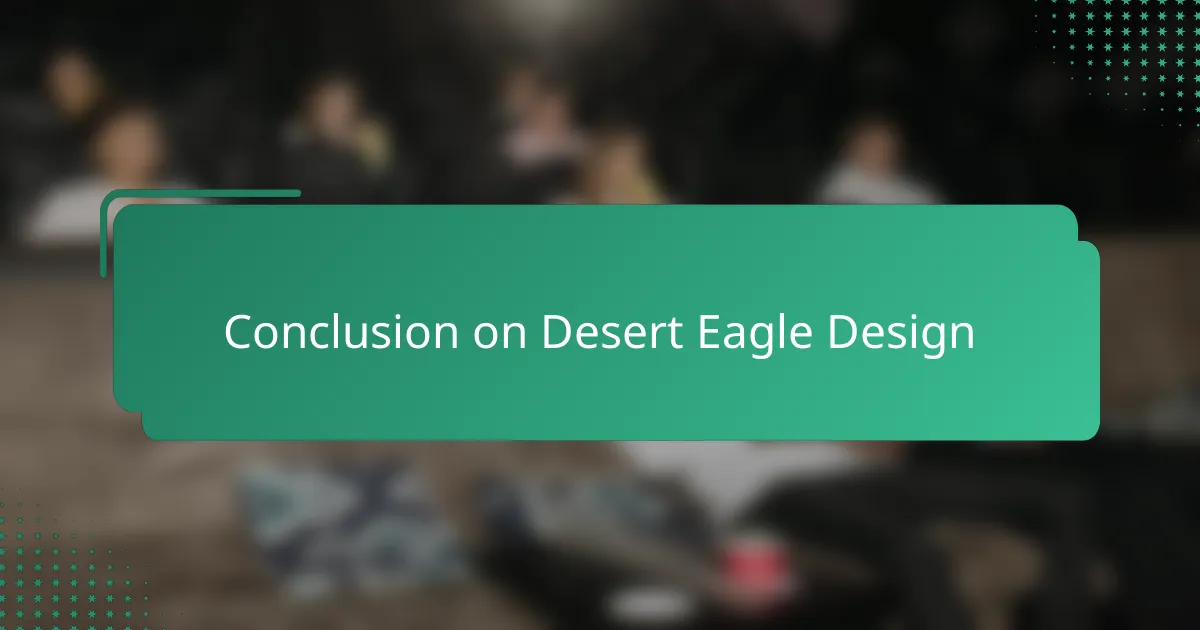
Conclusion on Desert Eagle Design
Looking back at the Desert Eagle’s design, I’m convinced that its boldness is its greatest strength. The sheer presence it commands on screen is unmatched, and I think that’s no accident—this prop wasn’t meant to blend in but to dominate every frame. Have you ever noticed how some designs just refuse to be ignored? This is definitely one of them.
That weighty feel I experienced holding the prop really sticks with me, too. It’s as if the designers wanted you to physically sense the power it represents. To me, that tactile connection elevates the Desert Eagle beyond just a cool-looking prop; it becomes something you can almost believe might exist in a futuristic world.
Of course, there’s room for growth. I often wonder how different it would feel if the prop incorporated subtle lighting or ergonomic tweaks without losing its iconic bulk. Would those changes deepen the immersion or risk softening the impact? From what I’ve seen, thoughtful upgrades like these could only add layers to an already compelling design.
